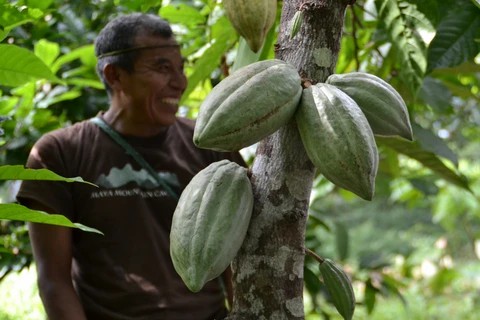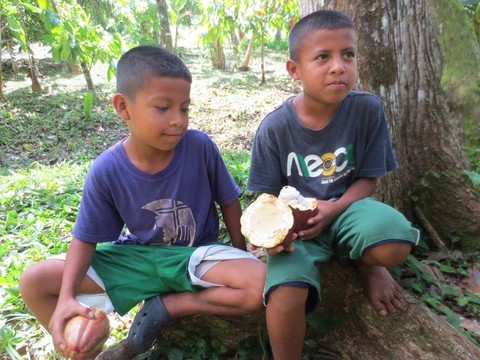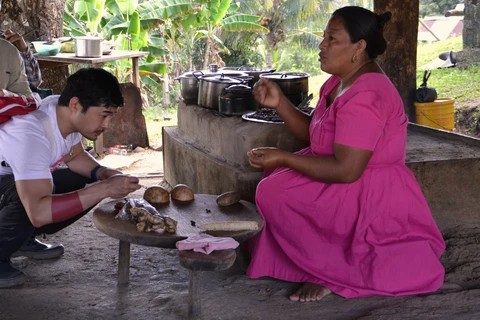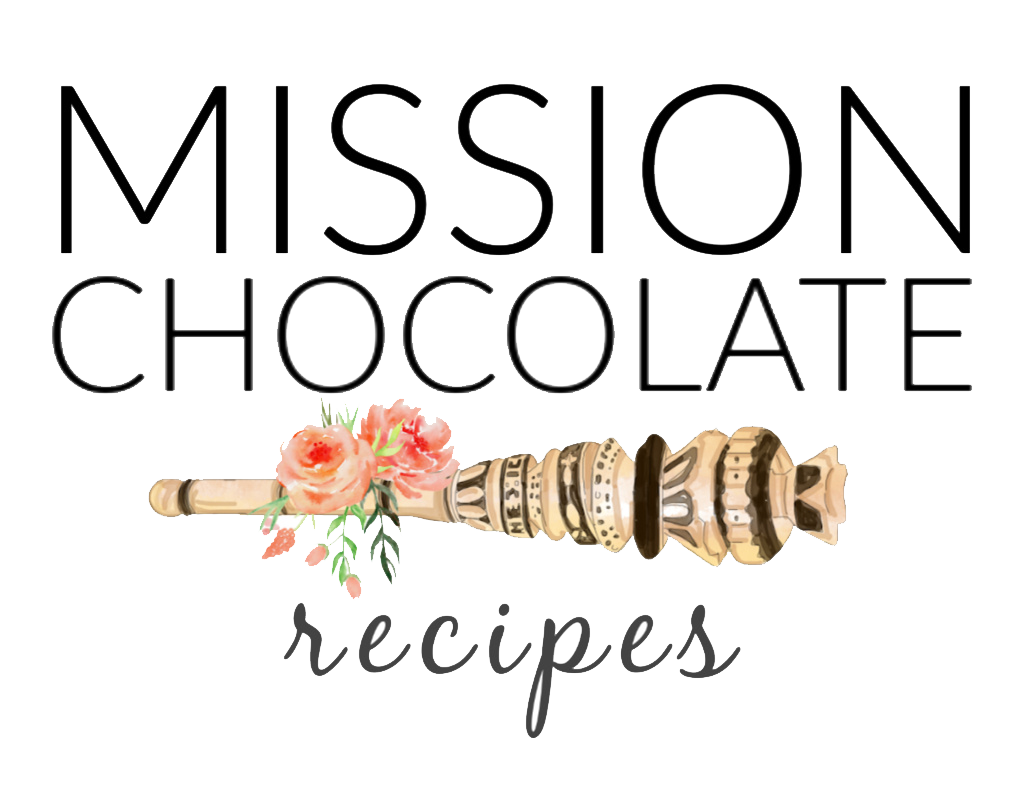Cacao in Belize – 6 Chocolate and Cacao related tours and classes
People always seem confused when I say I travel for cacao. Take my recent trip to Belize as an example. Most assumed it was for scuba diving or snorkeling, as diving experts deem the country as having the second best, if not the best, reef in the world. Few realize how the country is probably the most appropriate launch pad for my two month long choco-journey.
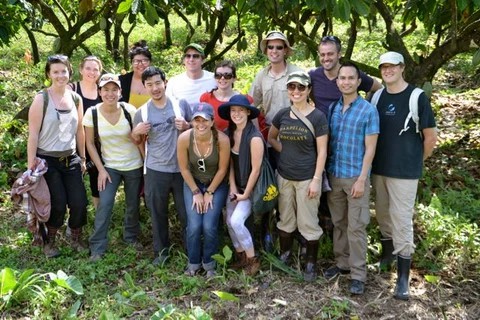
Belizean cacao has come a long way in the past 15 years, becoming the first in the world to be certified both organic and fair trade. Its quality has gained recognition in the US, as small batch chocolate makers have won awards for their Belizean single origin bars. Part of the allure is driven by the fact that English is the national language and that the Maya, the people with the longest chocolate making tradition in the world, speak it. It helps that the country is small, making it rather easy to navigate, and safe. Further, the government has enacted policies to encourage private business and exportation. Belize is the only country in the Americas that can boast these facts.
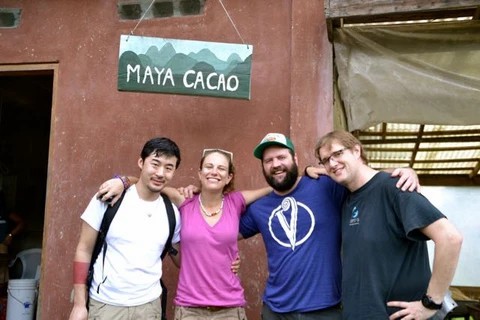
Belizean cacao, from Pre-Columbian times to the late 20th century. By the time the Spanish arrived to the Americas, cacao had already been cultivated and consumed for nearly 2,000 years by the Olmec, Aztec and the Maya. The Maya were synonymous with cacao, cultivating the crop in southern Mexico, Guatemala, Honduras, and Belize. It was mostly consumed as a drink, served during special ceremonies. Interestingly, it also served as currency. To this day, a Maya wedding (or any other important festivity for that matter) is not complete without a cacao drink.
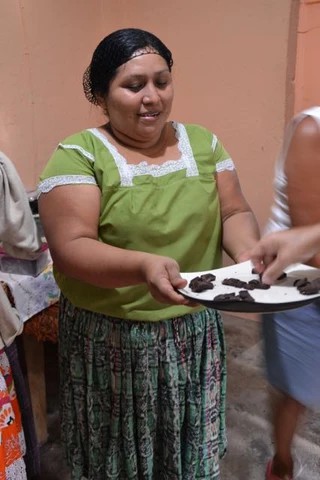
Beginning in the 1800’s most cacao production shifted to Africa for a number of reasons: the ravaging of crops in the Americas by fungal disease, relatively cheaper labor and closer proximity to the colonies of the countries that had excelled in modern chocolate making specifically France, Belgium, England, and Spain. Also, population slowly decreased in the cacao growing regions. European chocolate makers did not prioritize source, focusing on quantity rather than quality, as they figured they could create a consistent chocolate flavor, masking any inadequacies with disproportionate amounts of sugar, perhaps even with milk solids. Not that milk chocolate is a bad thing, but it overshadowed cacao aroma and less importance was placed on origin and “prime beans”. This is good or bad depending on how you see it. Many people have been returning to the Americas for high quality beans and they exist because the world kind of forgot about them for a while.
Belizean cacao today. The small-batch, bean to bar chocolate industry has grown markedly over the past decade. Chances are you have heard of or tried Dandelion Chocolate, Mast Brothers, Fruition, Madre, Tcho, Patric, to name a few US makers. The goal of these artisanal chocolate makers is to source beans from a single origin, most adding sugar as the ONLY other ingredient. These companies also happen to care very much about improving the supply chain which in turn would lead to improving cacao quality. And why does having a quality supply chain matter?
A lot of farmers don’t understand how to dry or ferment for this industry. If it’s bad stuff no one will buy it for top dollar. If they don’t make enough money growing cacao they abandon their farms. Or worse they plant other crops that don’t allow agroforestry; the delicate science of creating more diverse, productive, profitable, healthy, and sustainable land. If the farmer isn’t happy, their children will likely opt to search jobs in the city instead of farming. Who will grow the cacao? A machine will never replace a farmer. It takes the effort of chocolate makers, as backwards as it seems, to teach farmers about chocolate. Most of them have never tasted chocolate. It takes these chocolate makers to help farmers understand how to grow and treat quality beans to earn top dollar.
If you want to learn more about cacao and chocolate, Belize is a great place to start. You can stop by anytime to do the below activities although Dandelion Chocolate and Taza Chocolate organize “Chocolate Week” in conjunction with Cotton Tree Lodge. The best time of the year to visit is February but March hosts an annual cacao grower meeting where you can meet farmers and talk to them about their experiences. May is the “Toledo Cacao Festival” sponsored by a local cacao growers association.
6 Chocolate things to do in Belize:
1. Moho Chocolate in Belize City. This is the biggest chocolate factory in Belize. They only use organic chocolate from southern Belize. Here you can see how cacao turns into chocolate bars. These bars are sold around the country including the airport and in NYC at Roni-Sue’s shop in the Lower East Side. They make custom chocolate.
2. Toledo Cacao Growers Association (TCGA) in Punta Gorda. This association has been around since the early 1980’s and has the honor of representing the first cacao to be certified organic and fair trade in the world. TCGA beans are used by Green & Black’s for their Maya Gold bar. They are happy to meet with you and teach you about cacao in Belize. You can generally walk in between 10am-3pm.
3. Cotton Tree Chocolate in Punta Gorda. A small-batch, bean to bar shop, right by the Caribbean Sea, that only uses Belizean beans. You can see how bars are made, the Cotton Tree way: coffee roasters for roasting cacao, a hand drill for cracking the beans, a blow dryer for winnowing and a juicer for grinding. Here you can find cacao bean earrings, cacao lip balm, and cacao soap among other inspired gifts.
4. Maya Mountain Cacao (MMC) in Santa Ana (outside of Cotton Tree Lodge). Here you can get a glimpse of how the crucial step of drying and fermentation happens. MMC is a newcomer to Belize and has been processing beans for nearly fours years. Some of the more popular companies that use their cacao: Dandelion Chocolate, Mast Brothers, Dick Taylor, and Taza. Gabriel, the on-site manager is more than happy to talk to you about the process of turning seeds into beans.
5. Ix Cacao in San Felipe. I have seen Ix Cacao grow tremendously in the last four years. The owner, Juan Cho, prides himself on Ix Cacao being a 100% Maya-staffed and Maya-owned bean to bar chocolate company. They grow some of their own cacao and purchase the rest from local growers. They started by grinding their cacao, sugar and flavors on a volcanic rock (metate). Since the first time I saw them they have upgraded to some mechanic devices but keep true to the spirit of minimal processing. You can get a lesson on the history of chocolate, chocolate making and enjoy an amazing traditional Maya lunch (some dishes with cacao), all prepared on site.
6. Eladio’s Chocolate Adventure in Santa Ana. I can’t explain it, you just have to experience Eladio. This is my third time taking the tour he leads through his farm and he seems to get better with age. He energetically walks you through his cacao trees where you will be tasting everything that is edible; bananas, ginger, peanuts, pineapple, papaya, lemongrass, heart of palm, corn, etc. He can make you a belt or a hat or anything from organic matter. The tour leads to his home where his daughter shows you how to toast, crack, winnow, grind and make chocolate using ancient Maya techniques. It ends with an incredible Maya lunch, 100% Eladio grown.
